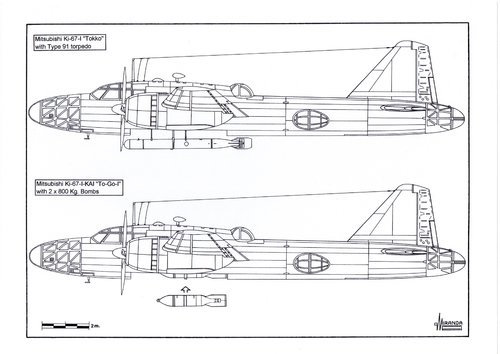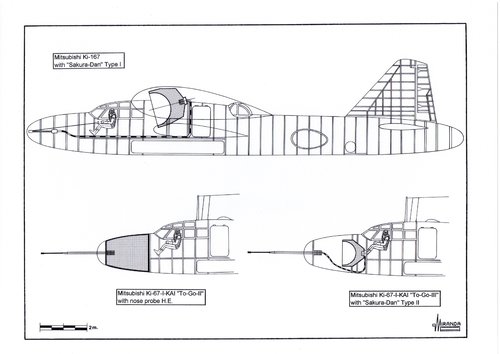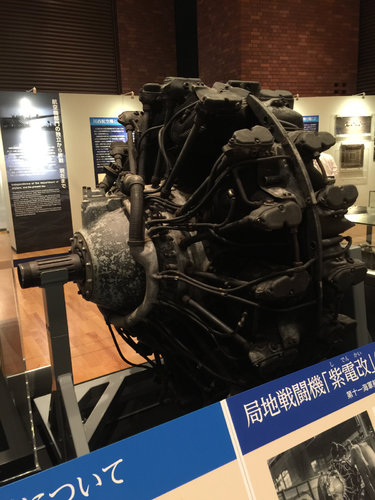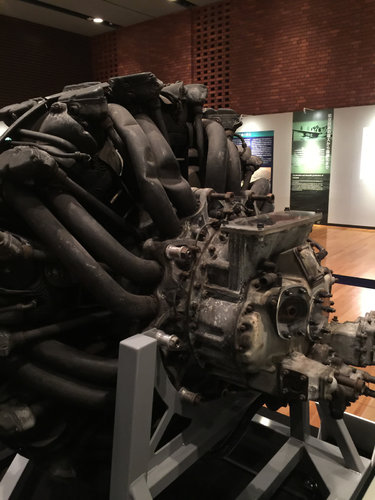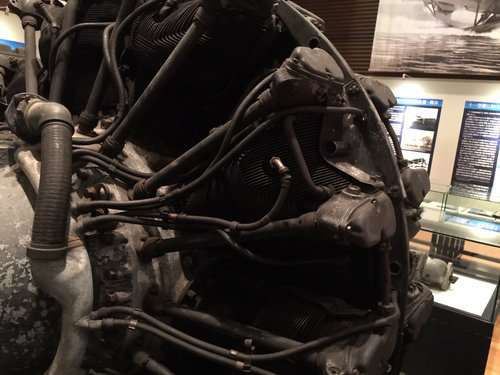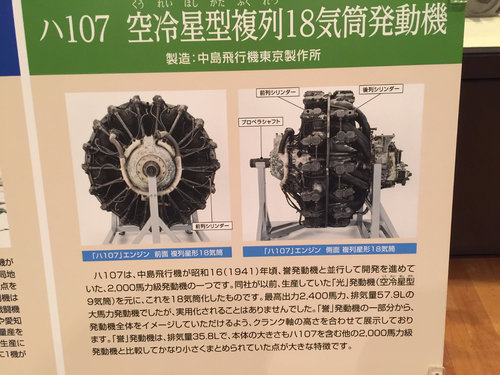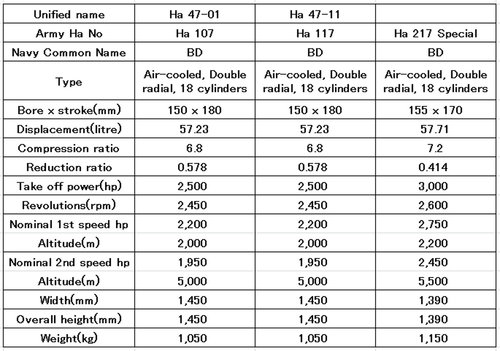I'm aware that there are a few instances of Japanese aircraft having successors designed immediately after they went in production, to try and keep a technological edge. That being said, I'm interested if there were any plans to replace the Ki-67 bomber.
You are using an out of date browser. It may not display this or other websites correctly.
You should upgrade or use an alternative browser.
You should upgrade or use an alternative browser.
Ki-67 Replacement?
- Thread starter Noveos
- Start date
Let me check this. Very hard question for me.
Thank you! Please don't work too hard over this
Mitsubishi Ki.167Among all medium bombers used by the IJA, the Ki.67-I was the most suitable to make Tokko attacks. It was a fast and manoeuvrable airplane that achieved some successes against the US ships at Formosa and Ryukyu Island. It also made conventional attacks against the B-29s bases located in the Marianas, operating from Iwo Jima.
In January 1943, one Ki.67-I was modified to carry the IJN standard aerial torpedo Type 91 Model II of 450 mm. After conducting several tests with good results, hundred units of this aircraft were manufactured for the IJN and IJA. The naval version, named Yasukuni, was equipped with Type H-6 radar and Yagi antennas.
In the autumn of 1944, a joint IJA / IJN unit of Ki.67s torpedo planes was formed, integrated by 7th and 98th Sentais and 762nd Kokutai, operating from Formosa under naval control. The first suicide attack of the Peggy took place on January 6, 1945 when four planes of the 501st Special Attack Squadron, from the 7th Sentai, attacked a US carrier Task Force east of Taiwan. On the 24th, ten aircraft of the Sichisei Kojun Unit conducted suicide attacks using torpedoes against a British carrier Task Force off Sumatra.
On March 30, a torpedo-plane of the Shinbu Special Attack Unit Kanegawa made a Tokko attack on Allied ships off Okinawa Island. On April 25, four suicide Peggys of the 110th Sentai attacked Allied ships south-west of Kadena. On May 24, a Ki.67-I of the 60th Sentai acted as a guide plane of the Giretsu airborne unit, integrated by twelve Ki.21 bombers. On 19 June, eight torpedo-planes of the Sichisei Jinrai Unit conducted a Tokko attack against British ships off Balikpapan. Six days later, in the same area, the Sichisei repeated the attack.
By mid-July, the First Air Arsenal at Tachikawa received orders to modify several Ki.67-I in a similar way to the Mukade variant of the P1Y1 Ginga, in order to make long range Giretsu strafing attacks against the bases of the B-29 located in Saipan. The Giretsu suicide missions were considered one-way only because of its long range and the absence of escort fighters. The modification consisted of installing four remote-controlled 20 mm cannons, with 300 rounds each in the bomb bay, angled 30 degrees downwards to be fired towards the ground, and flexible mounts for other four cannons in the nose and tail turrets.
After the end of the war, the first aircraft had been modified by 60 percent and Mitsubishi was working on a 2,500 km. long-range variant with additional fuel tanks in the fuselage and droppable fuel tanks under the wings. In July 1944, the IJA started the To-Go programme, a series of modifications to adapt its fleet of bombers to the new strategy of suicide attacks already started by the IJN. That same month, the 1st Army Air Arsenal at Tachikawa commissioned the transformation of twelve Ki.48 aircraft into the suicide version of the Ki.48-II-KAI-Otsu equipped with bombs of 850 kg.
In August, the modifying of some Ki.49 into the suicidal variant of the Ki.49-II-KAI was started. Two 850 kg bombs were also installed inside the Ki.67, a modification that was the origin of the Ki.67-I-KAI version. To that purpose, it was necessary to eliminate much of the internal equipment and armament, replacing the nose and tail turrets with plywood aerodynamic fairings and reducing the crew to three men. The anti-ship bombs used by the IJA in 1944 were Type 3, No. 80, Mark 8 with an actual weight of 850 kg that were considered more effective than the naval model of 807.5 kg that equipped most of the suicide planes. For the To-Go missions, the Type 3 bombs were modified by replacing the tail fuse with another electrically powered by means of an extended probe located in the nose airplane.
In total, 32 To-Go aircraft were modified and conducted suicide attacks against Allied ships between November 7, 1944 and April 25, 1945, operating with the special attacks units Fugaku and Tokko sections of the 62nd and 110th Sentais. In late 1944, the IJA concluded that the Ki.48s and Ki.49s equipped with conventional bombs were not effective in suicide attacks. The antiship bombs designed to pierce the heavy armoured decks of capital ships did not contain enough amount of HE Type 98 to cause serious damage, as they were located inside an aircraft that impacted at a relatively slow speed, compared to what could be achieved when the bombs dropped from a great height.
Another modification, made at least to one Ki.67, involved the installation of a large load of HE in the nose cone, that was electrically detonated by an extended probe. But the device did not turn out to be destructive enough during the flying tests. In late 1943 the Luftwaffe completed the testing of a new secret bomb named SHL-3500, a huge hollow charge 2 m in diameter containing 1,700 kg of HE. When exploding against a hard target generated a 4,000 degrees Celsius jet of molten metal from liner travelling at over twenty times the speed of sound. The jet could drill a hole through more than 8 m of armoured steel or 20 m of reinforced concrete.
The SHL-3500 bombs were designed to be carried in Mistel configuration by a specially modified Junkers Ju 88 and the Germans were manufacturing the SHL-6000 version, 3.9 m in diameter, to adapt it to the He 177 Heinkel in 1945. The Japanese acquired the hollow chargers technology in October 1942 and by mid-1944 had already developed their version of 1.6 m diameter of the SHL bomb, called Sakura-Dan. During the tests performed in Pai-Chengzi, Manchuria, the bomb was able to penetrate up 25 m in the simulated structure of a battleship.
With 2,900 kg, Sakura-Dan was too heavy to be installed in the nose of a medium bomber and it was decided to modify the central section of the fuselage of a Ki.67 to place it on the centre of gravity of the aircraft, angled at 15 degrees downwards. Five aircraft were thus modified under the designation Ki.167 with an extended probe of 2 m which contained three electrical crush fuses, with selection in flight, based on the German model EI.AZ(45) A.
At least two Ki.167s were used in combat by the 62nd Sentai. On April 2, 1945, the s /n 5033 along with a Ki.67 To-Go and six Ki.84 escort fighters participated in an attack on Allied ships east of Kikai Island. On May 25, the s /n 5027 accompanied three other
To-Go and some Ki.84 in a new attack west of Naha. In a report published by the U.S.A.A.F. in 1946, a smaller version called Sakura-2 is described that had 1.12 m of diameter and a weight of 1,300 kg and had been designed to be installed on the nose of the To-Go bombers. The usual stand-off probe is not represented in the drawings so it is unknown what would have been the trigger mechanism. Some sources suggest a derivative from the Type 3 photoelectric influence fuse.
Attachments
blackkite
Don't laugh, don't cry, don't even curse, but.....
- Joined
- 31 May 2007
- Messages
- 8,286
- Reaction score
- 5,834
Justo-san, you know every thing!!
I'm not sure that following description is the answer of the Noveos-san's question or not.
Nakajima Ki 82 heavy bomber (heavy bomber Otsu(B))
Purpose and mission
This was an aircraft based on the "Heavy Bomber Otsu(B)" proposal, which was a high-speed bomber that emphasizes speed based on the research policy established in 1940, and was planned to be prototyped by Nakajima Aircraft.
Plan summary
There were first and second plans for the Ki-82 bomber.
The first plan was an orthodox design plan equipped with Ha 45 engine. The maximum speed was calculated to be 580km / h.
The second plan was a design plan equipped with the liquid cooling prototype engine Ha39. As the engine cooling method, there were a design plan to equip a normal radiator and an ambitious design plan to equip the main wing with a surface cooler. The maximum speed of the design with a standard radiator was calculated to be 610-620km / h. The maximum speed of the design plan with a surface cooler on the wing was calculated to be 650km / h-670km / h.
However, the Ki 67, which belongs to the "heavy bomber Ko(A)" prototyped by Mitsubishi, became a reasonably high-speed aircraft, and the performance-improved model equipped with the Ha 214 engine was expected to exhibit a maximum speed of 630-640 km / h. The Ki-82 heavy bomber prototype was discontinued.
Source : The IJA military aircraft perefect guide 1910-1945, Gakken, ISBN4-05-603757-4
Liquid cooling prototype engine Ha39's detail are unknown.
Ha-214 engine's specification are as follows.
Ha 42-21 (Ha-214)
Dry weight: 1,260 kg, Fuel supply system: Fuel injection system, Compression ratio: 6.7
Supercharger: Centrifugal supercharger 1-speed 2-speed
Others: Water methanol injection device
Take off power 2,400 hp / 2,600 rpm
Nominal power
1st speed 2,300 hp / 2,500 rpm / boost +300 mmHg (altitude 2,000 m)
Second speed 2,000 hp / 2,500 rpm / boost +300 mmHg (altitude 6,400 m)
Ha 42-21 Le (Ha-214 Le)
Supercharger: Exhaust turbine + centrifugal supercharger 1st stage 2nd speed
Others: Water methanol injection device
Take off power 2,500 hp / 2,800 rpm
Nominal power
1st speed 2,300hp / 2,500 rpm / boost +300 mmHg (altitude 2,000m)
Second speed 2.000hp / 2,500 rpm / boost +300 mmHg (altitude 6,400 m)
Ha-42-31 (Ha-214Fu)
Supercharger: Centrifugal supercharger 1-speed 2-speed + Vulkan coupling drive continuously variable centrifugal supercharger x 2
Others: Water methanol injection device
Take off power 2,300 hp / 2,600 rpm
Nominal power
1st speed 2,130 hp / 2,500 rpm (altitude 1,600 m)
Second speed 1,750 hp / 2,500 rpm (altitude 8,300 m)
I'm not sure that following description is the answer of the Noveos-san's question or not.
Nakajima Ki 82 heavy bomber (heavy bomber Otsu(B))
Purpose and mission
This was an aircraft based on the "Heavy Bomber Otsu(B)" proposal, which was a high-speed bomber that emphasizes speed based on the research policy established in 1940, and was planned to be prototyped by Nakajima Aircraft.
Plan summary
There were first and second plans for the Ki-82 bomber.
The first plan was an orthodox design plan equipped with Ha 45 engine. The maximum speed was calculated to be 580km / h.
The second plan was a design plan equipped with the liquid cooling prototype engine Ha39. As the engine cooling method, there were a design plan to equip a normal radiator and an ambitious design plan to equip the main wing with a surface cooler. The maximum speed of the design with a standard radiator was calculated to be 610-620km / h. The maximum speed of the design plan with a surface cooler on the wing was calculated to be 650km / h-670km / h.
However, the Ki 67, which belongs to the "heavy bomber Ko(A)" prototyped by Mitsubishi, became a reasonably high-speed aircraft, and the performance-improved model equipped with the Ha 214 engine was expected to exhibit a maximum speed of 630-640 km / h. The Ki-82 heavy bomber prototype was discontinued.
Source : The IJA military aircraft perefect guide 1910-1945, Gakken, ISBN4-05-603757-4
Liquid cooling prototype engine Ha39's detail are unknown.
Ha-214 engine's specification are as follows.
Ha 42-21 (Ha-214)
Dry weight: 1,260 kg, Fuel supply system: Fuel injection system, Compression ratio: 6.7
Supercharger: Centrifugal supercharger 1-speed 2-speed
Others: Water methanol injection device
Take off power 2,400 hp / 2,600 rpm
Nominal power
1st speed 2,300 hp / 2,500 rpm / boost +300 mmHg (altitude 2,000 m)
Second speed 2,000 hp / 2,500 rpm / boost +300 mmHg (altitude 6,400 m)
Ha 42-21 Le (Ha-214 Le)
Supercharger: Exhaust turbine + centrifugal supercharger 1st stage 2nd speed
Others: Water methanol injection device
Take off power 2,500 hp / 2,800 rpm
Nominal power
1st speed 2,300hp / 2,500 rpm / boost +300 mmHg (altitude 2,000m)
Second speed 2.000hp / 2,500 rpm / boost +300 mmHg (altitude 6,400 m)
Ha-42-31 (Ha-214Fu)
Supercharger: Centrifugal supercharger 1-speed 2-speed + Vulkan coupling drive continuously variable centrifugal supercharger x 2
Others: Water methanol injection device
Take off power 2,300 hp / 2,600 rpm
Nominal power
1st speed 2,130 hp / 2,500 rpm (altitude 1,600 m)
Second speed 1,750 hp / 2,500 rpm (altitude 8,300 m)
Last edited:
windswords
ACCESS: Secret
- Joined
- 19 May 2009
- Messages
- 387
- Reaction score
- 193
More on the Ki-82 bomber project. Credit: Military History Encyclopedia on the Web
The Nakajima Ki-82 was a design for a new aircraft to replace the disappointing Nakajima Ki-49 Donryu, but the success of the Mitsubishi Ki-67 meant that the design was never completed.
During the 1930s Mitsubishi had produced most Japanese heavy bombers, but in 1938 they lost out to the Nakajima Type 100 Heavy Bomber Donryu (Ki-49). This was meant to replace the Mitsubishi Ki-21 Type 97 Bomber, but the new aircraft didn't live up to expectations and never fully replaced the older aircraft.
At the start of 1941 the Japanese Army asked Mitsubishi to begin work on a new bomber to replace the Mitsubishi Ki-49. Mitsubishi were able to reply very quickly and their draft outline was approved on 17 February 1941. This design would become the Mitsubishi Ki-67 Hiryu, the Japanese Army's best bomber of the Second World War.
Nakajima wasn't asked to produce its own design for a new bomber until later in 1941. The new aircraft was to be a smaller and lighter version of the Ki-49. Work began at Nakajima's Mitake Research Division, but by the middle of 1942 it was clear that the design wouldn't be competitive and work on the Ki-82 was abandoned.
The Nakajima Ki-82 was a design for a new aircraft to replace the disappointing Nakajima Ki-49 Donryu, but the success of the Mitsubishi Ki-67 meant that the design was never completed.
During the 1930s Mitsubishi had produced most Japanese heavy bombers, but in 1938 they lost out to the Nakajima Type 100 Heavy Bomber Donryu (Ki-49). This was meant to replace the Mitsubishi Ki-21 Type 97 Bomber, but the new aircraft didn't live up to expectations and never fully replaced the older aircraft.
At the start of 1941 the Japanese Army asked Mitsubishi to begin work on a new bomber to replace the Mitsubishi Ki-49. Mitsubishi were able to reply very quickly and their draft outline was approved on 17 February 1941. This design would become the Mitsubishi Ki-67 Hiryu, the Japanese Army's best bomber of the Second World War.
Nakajima wasn't asked to produce its own design for a new bomber until later in 1941. The new aircraft was to be a smaller and lighter version of the Ki-49. Work began at Nakajima's Mitake Research Division, but by the middle of 1942 it was clear that the design wouldn't be competitive and work on the Ki-82 was abandoned.
blackkite
Don't laugh, don't cry, don't even curse, but.....
- Joined
- 31 May 2007
- Messages
- 8,286
- Reaction score
- 5,834
Hi! This Nakajima Ha-107(Ha-47) engine for heavy bomber is exhibiting in Yamato museum now.
This engine was developped from Hikari engine, maximum power was 2400hp, displacement was 57.9L, development terminated because engineers were busy for modification of Homare.
I imagine that this engine had some relation to Ki-82 heavy bomber. This engine was developped in parallel with Homare Ha-45 2000hp class engine(displacement 35.8L).
This engine was developped from Hikari engine, maximum power was 2400hp, displacement was 57.9L, development terminated because engineers were busy for modification of Homare.
I imagine that this engine had some relation to Ki-82 heavy bomber. This engine was developped in parallel with Homare Ha-45 2000hp class engine(displacement 35.8L).
Attachments
Last edited:
Hi! This Nakajima Ha-107(Ha-47) engine for heavy bomber is exhibiting in Yamato museum now.
This engine was developped from Hikari engine, maximum power was 2400hp, displacement was 57.9L, development terminated because engineers were busy for modification of Homare.
I imagine that this engine had some relation to Ki-82 heavy bomber. This engine was developped in parallel with Homare Ha-45 2000hp class engine(displacement 35.8L).
I wonder if the Ki-82 would've been better then? It seems these engines are better than the upgraded Kasei used on the Ki-67
blackkite
Don't laugh, don't cry, don't even curse, but.....
- Joined
- 31 May 2007
- Messages
- 8,286
- Reaction score
- 5,834
Hi! HA-107 specification.
https://rikukaigunki.nobody.jp/engine/nakajima.html
https://rikukaigunki.nobody.jp/engine/nakajima.html
Attachments
Airborne2001
ACCESS: Confidential
- Joined
- 19 June 2020
- Messages
- 135
- Reaction score
- 125
While it is not an entirely new plane, there was the Ki-67-II with stronger engines. It had two engines that produced 2,150hp; Mitsubishi Ha-214's.
ceccherini
In war there is no substitute for victory
- Joined
- 26 February 2015
- Messages
- 160
- Reaction score
- 155
Ki-67 was probably the best medium bomber in the world with the only defect of the light bomb load. That defect only made stronger the need to concentrate resources in the development of heavy, 4 engines bombers and not sparing them in the quest for marginal improvements over an already excellent design. I see no point in a clean sheet 2 engines design in 1944, it was certainly better to invest on Ki-91 or similar planes.I'm aware that there are a few instances of Japanese aircraft having successors designed immediately after they went in production, to try and keep a technological edge. That being said, I'm interested if there were any plans to replace the Ki-67 bomber.
Ki-67 was probably the best medium bomber in the world with the only defect of the light bomb load. That defect only made stronger the need to concentrate resources in the development of heavy, 4 engines bombers and not sparing them in the quest for marginal improvements over an already excellent design. I see no point in a clean sheet 2 engines design in 1944, it was certainly better to invest on Ki-91 or similar planes.I'm aware that there are a few instances of Japanese aircraft having successors designed immediately after they went in production, to try and keep a technological edge. That being said, I'm interested if there were any plans to replace the Ki-67 bomber.
I think medium bombers could serve some use, especially in tactical areas. Medium bombers costed less to operate, and were faster than many heavy bombers at low-medium altitudes. Of course, there was a need for strategic heavy bombers that the Germans and the Japanese ignored. The IJN would've been better off listening to Nakajima, I imagine, and furthering the development of the Fugaku.
Also in what ways was the Ki-67 the best medium bomber?
ceccherini
In war there is no substitute for victory
- Joined
- 26 February 2015
- Messages
- 160
- Reaction score
- 155
I'm not arguing Japanese were to substitute twin engines with 4 engines bombers, just that they had plenty of very advanced medium bomber designs alredy in production and a strong need to finally get a heavy bomber design in production. The point is Japanese used medium weight bombers, such as Ki-67, for strategic missions trading bomb load for range essentially because of financial and industrial constraints. As the war economy mobilized more resources and alleviate these constraints clearly the priority was for the heavy bombers. A very explaining fact is the cancelation of the twin engine G7M Taizan in favor of the heavy G8N. Ki-67 had a significant advantage over American and German medium bombers in speed and range, was equal to the very best in defensive armament and ceiling, was equal in robustness and armor (improving over previous Japanese designs), had outstanding, fighter like, flying characteristics. On the top of that, Japanese optical gunsight and radio equipment was really top rate. If not the best in the World a very strong candidate.Ki-67 was probably the best medium bomber in the world with the only defect of the light bomb load. That defect only made stronger the need to concentrate resources in the development of heavy, 4 engines bombers and not sparing them in the quest for marginal improvements over an already excellent design. I see no point in a clean sheet 2 engines design in 1944, it was certainly better to invest on Ki-91 or similar planes.I'm aware that there are a few instances of Japanese aircraft having successors designed immediately after they went in production, to try and keep a technological edge. That being said, I'm interested if there were any plans to replace the Ki-67 bomber.
I think medium bombers could serve some use, especially in tactical areas. Medium bombers costed less to operate, and were faster than many heavy bombers at low-medium altitudes. Of course, there was a need for strategic heavy bombers that the Germans and the Japanese ignored. The IJN would've been better off listening to Nakajima, I imagine, and furthering the development of the Fugaku.
Also in what ways was the Ki-67 the best medium bomber?
Last edited:
I'm not arguing Japanese were to substitute twin engines with 4 engines bomber, just that they had plenty of very advanced medium bomber designs in production and a strong need to finally get a heavy bomber design in production. The point is Japanese used medium weight bombers, such as Ki-67 for strategic missions, trading bomb load for range essentially for financial and industrial constraints. As the war economy mobilized more resources and alleviate these constraints clearly the priority was for heavy bomber. A very explaining fact is the cancelation of the twin engine G7M Taizan in favor of the heavy G8N. Ki-67 had a significant advantage over American and German medium bomber in speed and range, was equal to the very best in defensive armament and ceiling, was equal in robustness and armor (improving over previous Japanese designs), had outstanding, figther like, flying characteristics. On the top of that, Japanese optical gunsight and radio equipment was really top rate. If not the best in the World a very strong candidate.Ki-67 was probably the best medium bomber in the world with the only defect of the light bomb load. That defect only made stronger the need to concentrate resources in the development of heavy, 4 engines bombers and not sparing them in the quest for marginal improvements over an already excellent design. I see no point in a clean sheet 2 engines design in 1944, it was certainly better to invest on Ki-91 or similar planes.I'm aware that there are a few instances of Japanese aircraft having successors designed immediately after they went in production, to try and keep a technological edge. That being said, I'm interested if there were any plans to replace the Ki-67 bomber.
I think medium bombers could serve some use, especially in tactical areas. Medium bombers costed less to operate, and were faster than many heavy bombers at low-medium altitudes. Of course, there was a need for strategic heavy bombers that the Germans and the Japanese ignored. The IJN would've been better off listening to Nakajima, I imagine, and furthering the development of the Fugaku.
Also in what ways was the Ki-67 the best medium bomber?
Ah that makes so much sense. I completely agree with your assessment
Similar threads
-
-
Nakajima Ki-49 Donryu (Helen) special versions
- Started by Temistocle
- Replies: 6
-
-
-

